Australia has some incredible birdlife with around 850 species, 45% of which are found nowhere else in the world. It is also home to three flightless birds, including one that is considered to be the most dangerous bird on the entire planet?! This post is going to introduce you to the amazing flightless birds of Australia.
The 3 flightless birds native to Australia are the Emu, Cassowary, and Little Penguin. The Emu and the Cassowary are large birds between 1.5 meters and 2 meters tall. Little Penguins are around 30cm tall. These birds are only found in Australia, though Little Penguins also occur in New Zealand.
Continue reading to learn some fascinating facts about these three birds. You will discover some things you may never have heard of before, including the Great Emu War of 1932 when Australia declared war on a bird that already held a place on its coat of arms?!
Australia’s Smallest Flightless Bird
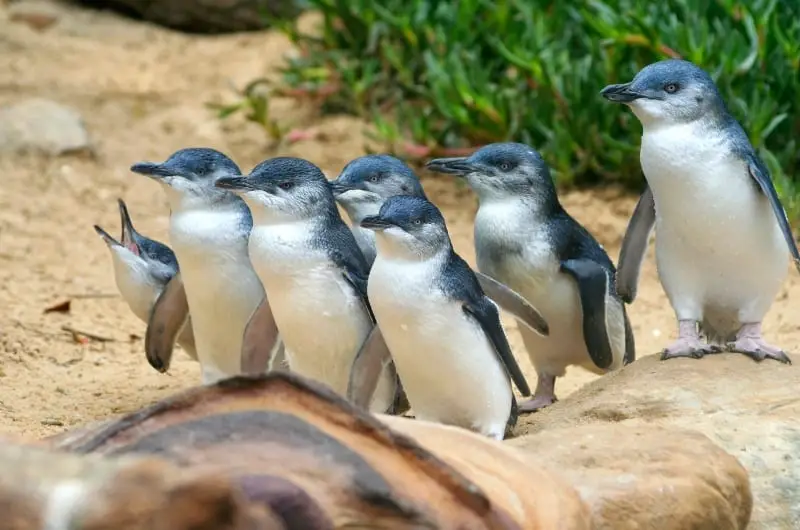
Australia’s smallest flightless bird is the Little Penguin. Also known as the Blue Penguin or Fairy Penguin they are the only species of penguin that breed in Australia. Little Penguins are around 30cm tall and weigh around 1kg. They are blue on their backs and heads and have white bellies.
These Australian flightless birds can also be found on islands from the NSW north coast, to Tasmania, and west to Carnac Island off Fremantle WA. There is also a colony of Little Penguins in New Zealand though some people believe these to be a separate species.
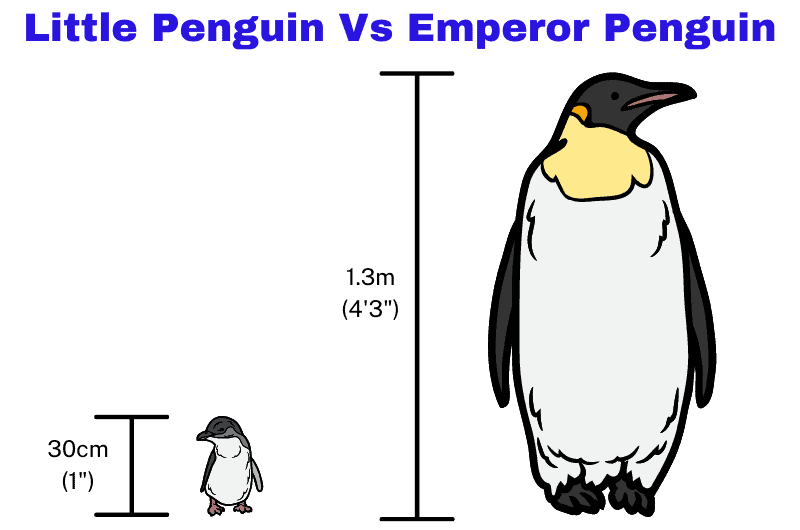
A Little Penguin’s Day At Sea
Little Penguins feed on small fish, cephalopods, and crustaceans, sometimes traveling 14 to 20 kilometers per day in search of them. They will spend all day out at sea from dawn until an hour before dusk, swimming about using their wings which are basically modified flippers.
A Little Penguin can dive from 6 to 69 meters deep and remain submerged for over a minute. Underwater they have a sprint speed of 1.5-2 meters per second, necessary to escape their predators which include sharks, sea eagles, and fur seals. On land, they are predated by snakes and goannas.
Read about 10 Australian birds that love to eat fish in this article here on my blog.
Burrowing and Egglaying
The burrows these small penguins dig can be up to 0.15 meters deep however on average they are around 0.4 meters deep. Both the male and female birds will dig the burrow in soft sand or soil and line it with a thick mat of grass or even just a few strands of grass collected from close to the burrow entrance.
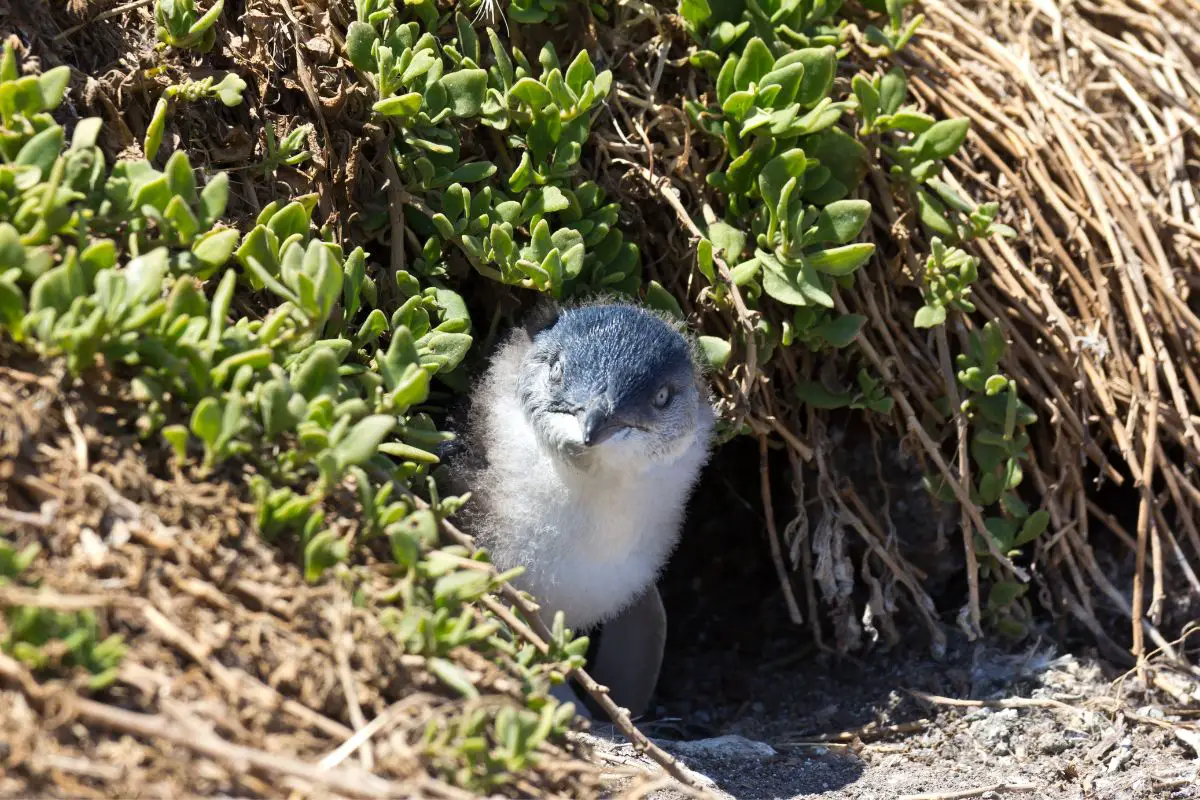
The female will lay two eggs two to three days apart from each other however amazingly, both eggs will hatch at the same time. Both parents incubate the eggs and tend to the young once hatched.
Why Can’t We Call Them Fairy Penguins Anymore?
Although famous for being Australia’s only penguin and the world’s smallest, Little Penguins have also been shrouded in controversy. In April of 2006, Seaworld on the Gold Coast in Queensland decided that their original name Fairy Penguins may be offensive to the gay community.
Though they had received no complaints about the name from the gay community, they still went ahead and began calling them Little Penguins and it stuck. Ironically, the gay community actually described the name change as ridiculous and unnecessary.
“If they were called poofter penguins or something more direct, it might be a problem. But I don’t see the name fairy penguin as a mickey take“
Kamahl Fox, chairman of gay support group Gold Coast Breakers
Fifteen years later, the name change still stands. Another example of political correctness gone completely mad!
Discover 17 funny Australian bird names in this article here on my blog.
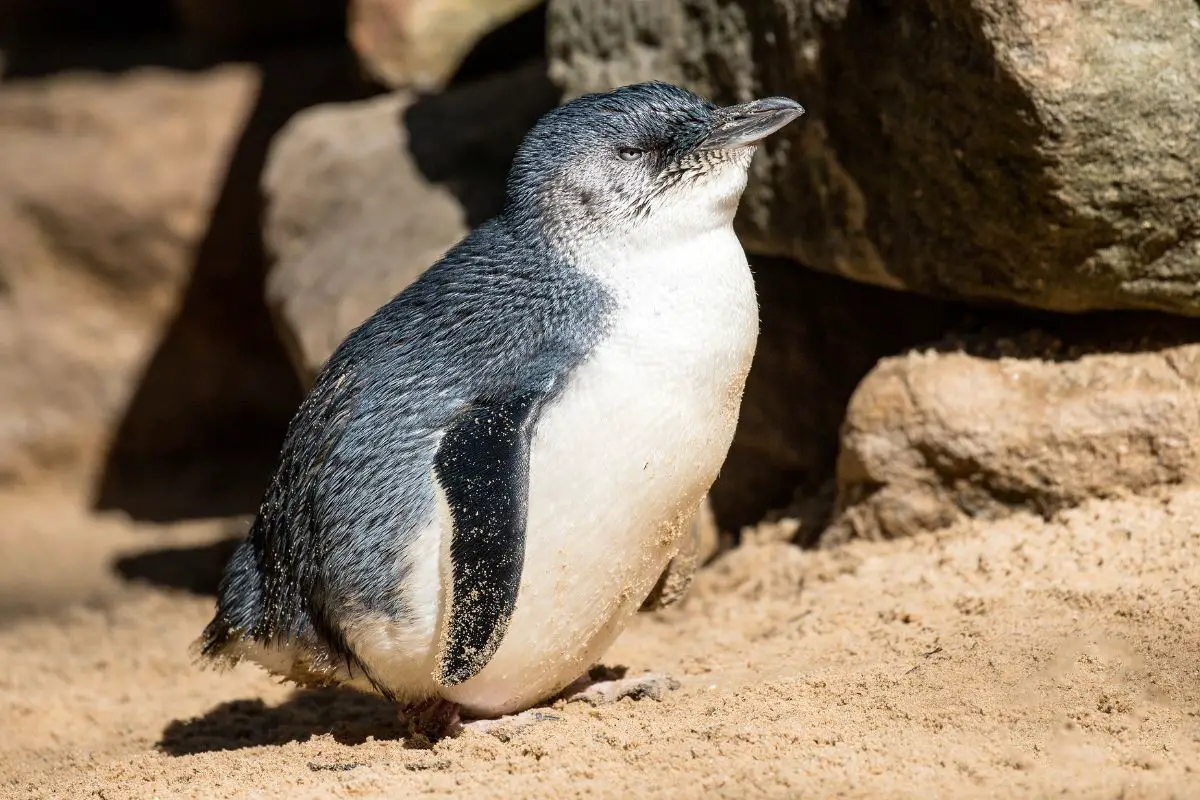
Little Penguins In The Movies
Seemingly ever-famous, Little Penguins were also featured in the 2015 Australian film, Oddball. Based on real events, this movie tells the story of an eccentric chicken farmer and his grandaughter who train a Maremma Sheepdog (Oddball) to protect Little Penguins and their nesting areas on Middle Island off the coast of Warnambool in Victoria.
The movie starred Shane Jacobson, Coco Jack Gillies, Sarah Snook, and Alan Tudyk, though Oddball and the Little Penguins were the real stars.
Australia’s Most Famous Bird That Can’t Fly

Ask anyone if they are aware of any Australian flightless birds and they most likely will say “Emu.” The Emu is the country’s largest bird at up to 2 meters tall, and perhaps its most iconic. It even appears on the coat of arms. It is in fact the world’s second-largest bird after the Ostrich.

Do Emus Have Wings?
Emus do have wings though they are relatively small compared to the size of their bodies and this, along with their 30-45kg body weight renders them flightless. They can be found anywhere throughout most of the continent from coastal areas to high in the mountains.
The Emu is not only second to the Ostrich in height but also in land speed. Don’t underestimate them though, they can still run at up to 50kph (31mph) and have a stride of around 3 meters?! They may not look very streamlined but damn that’s fast!
Breeding And Care Of Young
Mating pairs of Emus will stay together for up to five months. After this, the female will lay between five and fifteen eggs which the male then incubates for 55 days without ever leaving the nest. That’s right, he will not drink, feed, poo, or leave the nest for that entire time!

Once hatched, the chicks are cared for by their father for about 4 months when they are able to fend for themselves. The females move on after laying to mate with other males.
Discover more facts about how long birds stay in the nest in this post right here on my blog.
Can Emus Swim?
An interesting fact about Emus is they love to swim?! They love to take a dip to cool off on a hot day, or to get where they really need to go, like this one filmed crossing the Murray River near the South Australian border:
Is Emu An Aboriginal Word?
The word Emu is often considered to be an Aboriginal word, though it may have derived from an Arabic word for a large bird. This word was used by Portuguese explorers to describe Cassowaries. Early European explorers transferred the name to Emu.
In Victoria, an Emu is called a Barrimal in the Dja Dja Wurrung language. Other words for Emu in different Aboriginal dialects are myoure and courn.
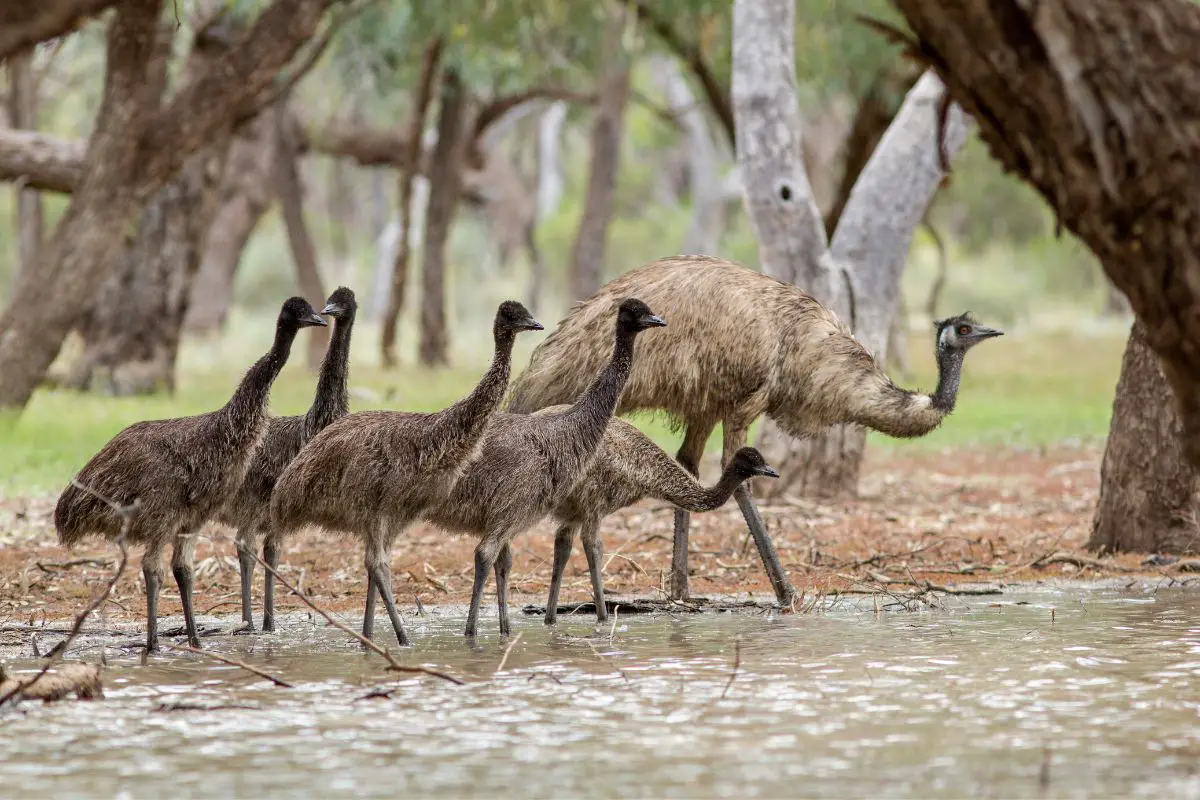
Australia Wages War On The Emu
You may not believe it but back in November of 1932, Australia declared war on the Emu?!
A population of at least 20,000 Emus was ravaging crops in the state of Western Australia and farmers petitioned for military aid from the then Minister of Defence George Pearce.
On the 2nd of November, 1932, the Seventh Heavy Battery of the Royal Australian Artillery arrived at Campion, a little over 300km northwest of Perth. They were carrying two Lewis automatic machine guns and around 10,000 rounds of ammunition. They had no idea of the enemy they were about to face…

Unknown author, Public domain, via Wikimedia Commons
It was not known until that day that Emus are extremely hard to kill with a machine gun! By the day’s end, only a dozen birds out of the thousands that were shot at were actually dead. Apart from being almost impossible to hit with machine-gun fire, the birds were also able to shrug off any injuries sustained without even breaking stride?!
“If we had a military division with the bullet-carrying capacity of these birds it would face any army in the world… They can face machine guns with the invulnerability of tanks.”
Major Meredith, Seventh Heavy Battery, Royal Australian Artillery
Within a week, the war was over. The troops were recalled, having fired roughly 2500 rounds and killing between 50 and 200 Emus.

The Most Dangerous Australian Flightless Bird
Meet the Southern Cassowary, Australia’s most dangerous flightless bird. Is this reputation justified though…?

The Southern Cassowary is one of three species of Cassowary found worldwide. Standing at around 2 meters tall and weighing up to 80kg, it’s no wonder these birds can’t fly. It is not their sheer size and weight that makes them so dangerous though, it’s their claws!
Meet Australia’s smallest bird in this article here on my site.
A Cassowary’s Claws
Cassowaries are equipped with three large, sharp claws on each foot. The innermost claw is around 12″ long and not something you want to be on the receiving end of. If it looks a little prehistoric, that’s because these birds are living dinosaurs, their lineage dating back to the Cretaceous period around 66 million years ago.

You might take one look at that massive foot above and think that Cassowaies are bloodthirsty killers, roaming the Australian forests looking to sink their talons into an unsuspecting animal or human… but you would be wrong. They actually prefer fallen fruit to eat and are responsible for regenerating the rainforest in tropical north Queensland. They will also eat anything from snails to small dead animals.
How They Help The Rainforest
The fruits Cassawaries eat have large seeds that other smaller animals and birds do not eat. These seeds pass through their digestive system and then quickly germinate in the poo of the birds, it’s like a natural fertilizer. In this way, they are responsible for the germination of many important tropical plant species.
Breeding And Life In The Forest
Like the Emu, female Cassowarries select a male with which to breed. Once she has laid the 3 to 8 large eggs, incubation and care of the young are left up to the male. Females are larger and more dominant than males.

It is quite hard to find a Cassowary in the wild, they are easily missed in the dense tropical rainforest as they are able to blend into the shadows. They will stand their ground if confronted. If the intruder comes closer, the bird will stand tall and let out a loud hissing sound to try and intimidate it. They will sometimes attack but usually retreat into the forest.
A Dangerous Reputation
The reputation of the Cassowary might be a little over-inflated. They can cause a lot of harm to a human with their huge claws and massive weight to throw behind them however, they have not been responsible for many human deaths.
In April of 1926, a 16-year-old boy called Phillip McClean died after he tripped over while fleeing from a Cassowary and was gored in the neck when stepped on. The only other death attributed to a Cassowary was a Florida man killed in April 2019 by a pet bird he kept on his property.

In 2021, a man by the name of Dennis Ward was kicked in the back by a Cassowary, fell down a 7-meter cliff, and bounced off a ledge into a body of water. I believe Dennis was unharmed.
“Next thing, thump, I copped a boot in the back and I was tumbling down the bank.”
Dennis Ward from an interview with the Cairns Post
Most attacks by Cassowaries occur when the birds are expecting to be fed by a human, when they are defending themselves, or when they are protecting their offspring.
So is the Cassowary’s dangerous reputation justified? Well, you might say it is. Remember we are talking about a bird that stands up to 2 meters tall, has two powerful legs that can propel it up to 7 feet in the air[1], and has 6 large talons up to 12″ in length. Pack all this into a bird that can run at up to 50kph (31mph) and you have one scary feathered creature?!
Where To See These Birds
So if you get the chance to come to Australia, where can you see these birds?

I have already mentioned the Philip Island Penguin Parade. This is a must-do experience during a trip to Phillip Island. Tripsavvy has a great blog post about this and other places to see Little Penguins that you can read.
For a list of places to see Emus in New South Wales, try this post from NSW National Parks and Wildlife Service. I can also recommend Wilson’s Promontory at the southern tip of Victoria as a great place to spy a mob of Emus.
For Cassawories, you must head north to Queensland. Try this post from the Cassowary Recovery Team website for tips on where to find them.
Of course, there are also many Zoos and Wildlife Parks that have these birds in their keep. Australia Zoo in Beerwah on the Sunshine Coast of Queensland has both Emus and Cassowaries but not Little Penguins. Billabong Zoo and also the Dolphin Marine Conservation Park, both in NSW have Little Penguins you can get up close and personal with.
References
- Our Top 10 Favorite Aussie Birds – Wildlife Stories
- Little Penguin – Penguin Foundation
- For The Birds, Southern Symbols – Fox News
- Penguins are no longer gay – Overlockers UK
- Emu – Bush Heritage Australia
- Southern Cassowary – Department of Environment and Science Queensland
- Florida man killed by cassowary he kept on his farm – The Sydney Morning Herald
- Commonwealth Coat of Arms – Department of Prime Minister and Cabinet Australian Government
- Emu name – The Australian Museum
- Little Penguin – Department for Environment and Heritage South Australia
- Common Emu Facts – National Geographic
- Looking back: Australia’s Emu Wars – Australian Geographic


